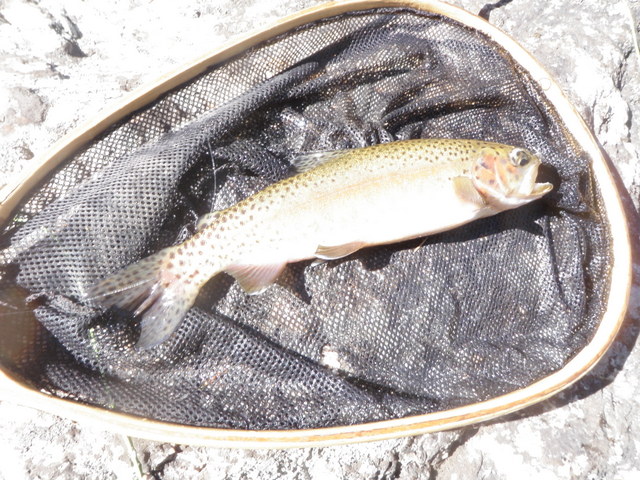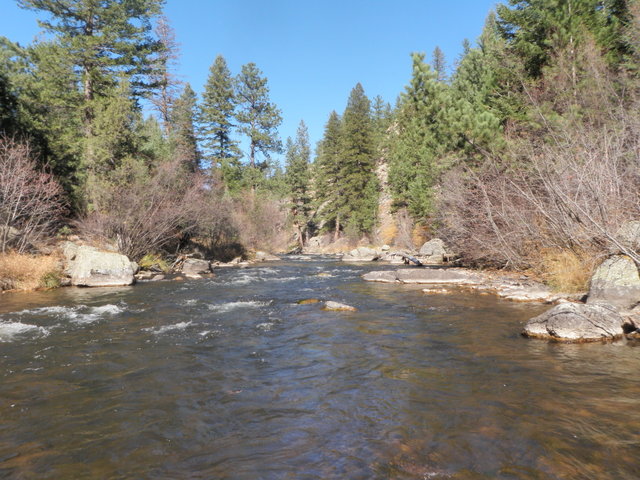Time: 12:00PM – 4:30PM
Location: 30 minute hike downstream from parking lot
Fish Landed: 16
South Boulder Creek 10/21/2012 Photo Album
After a rough outing on Wednesday I was anxious to find another opportunity to test the Colorado waters before hanging up my waders for the winter excepting of course the scheduled trip to Argentina in December. The weather forecast appeared to be favorable for Saturday and Sunday, so I chose Sunday as the day to make a late October fishing trip. The flows on South Boulder Creek were 95 and I can reach the water below Gross Reservoir in an hour and the stream supports a large population of rainbows who are not fall spawners, so this became my choice for Sunday.
I left the house a bit after 10AM and arrived at the parking lot shortly after 11. The lot was almost full, and I had to park next to the picnic table in the northeast corner. It was a pleasant day with air temperatures probably reaching the mid to high 60’s as I packed my lunch in my backpack along with my raincoat and assembled my Loomis 5 weight and began the hike down the path at roughly 11:20. I decided to hike beyond my furthest point to date and succeeded in this endeavor. By the time I tied on my Chernobyl ant with a trailing beadhead hares ear it was noon. I extended the tippet section that was tied to the bend of the Chernobyl to roughly three feet as I wanted to get deeper in the higher flows.
The Chernobyl/hares ear combination did not produce through some choice water so I clipped off the beadhead hares ear and added a beadhead Craven soft hackle emerger. Finally after fifteen minutes or so of additional fishing, a decent rainbow grabbed the BWO imitation at the tail of a deep run. Shortly after this, a small brown darted to the surface and snatched the Chernobyl ant. However, after this welcome success in the first hour, I began to experience refusals to the Chernobyl with no attention paid to the trailer, so I clipped off both flies and substituted a gray comparadun. This fly worked well for me in previous trips and the fly shop report suggested PMD’s and green drakes were still hatching.
I approached a nice pool with three current seams feeding the top and spotted a couple rises where the current fanned into the pool. I tossed the comparadun to the top and a nice brown tipped up and inhaled the mayfly imitation. Perhaps I’d chanced upon the winning fly for South Boulder Creek. Unfortunately this appeared to be a fluke because fish continued to rise in the riffled current at the top right of the pool, and they paid no attention to my offering. I studied the surface closely and spied two mayflies lifting off, but they were much smaller than a PMD and likely BWO’s so I switched to a CDC BWO. Unfortunately after a couple drifts, I tried to loop a cast above and to the right of a protruding dead branch, and as I picked up my line, the tiny fly lodged in the end of the branch. The only way to save the fly was to wade over and disturb the pool and the CDC fibers were now saturated and required drying and fluffing.
I moved on above this area, but I didn’t see any more rising fish nor did I see anymore BWO’s. What I did see however were small stone flies riding the surface and dapping and fluttering up from the stream. I managed to swipe one with my net and inspected it at close range. It was a size 18 body of dark brown-olive with smokey dark gray wings and black legs. The wings were almost twice the length of the body and I looked in my fly patch and fly boxes and found two size 16 dark olive caddis with undersized hackles, so I removed the one from my fly box and tied it to my line.
I began prospecting with the caddis in hopes that it would be a close enough imitation of the stoneflies and It was about this time that I approached a very attractive long riffle stretch. The area was roughly 25 feet wide and 30 feet long and I flicked some casts to the lower portion and below some overhanging branches. It didn’t require more than a cast or two and a small rainbow smashed the caddis, now stonefly imitation. I fanned some casts to the left and then covered the middle area and the top and landed six more fish on the stonefly in this area and in some nice water above the riffle area. The teeth of one of the browns broke the hackle stem so I clipped it off and fished the fly with only a wing and body and no hackle. This almost worked better than the hackled version as I landed several of the fish on this fly. One fish took the fly fairly deeply indicating that it didn’t suspect that it wasn’t a real stonefly.
Unfortunately as I moved along, the stonefly activity waned and I went through a slow spell, but around 3PM I began to notice legitimate BWO’s and rising fish. In a pool with some steady risers I decided to clip off the caddis and replace with a size 22 CDC BWO and this did the trick for the next 45 minutes as I landed three additional fish. If I could spot a rise and put myself in a position where the sun glare wasn’t too bad, I could dupe the fish with my tiny imitation. One of the nicer fish sucked in the CDC BWO just as it sank below the surface.
Once again however the hatch slowed and disappeared and the shadows began to extend over much of the stream. I exited at this point and hiked up the path looking for stretches of water that remained in the sun. I did manage to find several of these areas and as the lighting was now quite difficult, I abandoned the size 22 CDC BWO and tied on the other size 16 olive brown deer hair caddis. Over the remaining hour I picked up four more small trout on the caddis by fishing in sunlit areas. By 4:30 the entire canyon was covered with shadows although the temperature remained quite conducive to fishing, but I decided to hike back out and return home as I was already running late compared to the return time I’d communicated to Jane.
I was quite pleased to land sixteen fish on October 21 with nearly all taking flies on the surface, and I resolved to tie some size 18 stonefly imitations so I’m prepared for the next visit. I’ve concluded that South Boulder Creek is one of the few streams in Colorado where large attractor style flies do not perform. These educated trout seem to prefer offerings on the small side and flies that actually come close to imitating the real food that they see on a day to day basis. Go figure.



